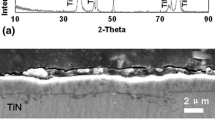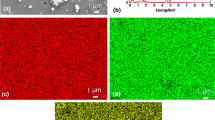Abstract
For the better understanding of anti-wear properties of hard coating films, the effects of preferred orientation, surface roughness, and surface hardness on the tribological property of TiN and CrN films have been studied. TiN and CrN films were deposited by cathodic AIP (CAIP) with working temperatures of 350∼450°C, working pressures of 1∼5Pa, arc currents of 50∼90 A, and bias voltages of 30∼150V. The characteristics of microstructure and its effect on the friction coefficient were investigated with working conditions. The preferred orientation of the film was examined by XRD. The friction coefficient was determined using ball on disk tribometer. The preferred orientation of films was changed from (200) to (111) with decreasing working pressure and increasing bias voltage. It is reported that TiN coating with strong (111) orientation have better tribological property, but, in this study, although similar tendency was also found in TiN, the tribological property was increased with diminishing (111) orientation in CrN films. It is concluded in this study that the tribological property is not affected only by the orientation of the film, but it depends on the combined properties of surface roughness, surface hardness, and orientation of the film. The friction coefficients of TiN and CrN were 0.48∼0.52 and 0.49∼0.53, respectively.
Similar content being viewed by others
References
J. P. Terrat, A. Gaucher, and L. Hadj-Rabah, Surf. Coat. Technol. 45, 59 (1991).
L. Cunha, M. Andritschky, L. Rebouta, and K. Pischow, Surf. Coat. Technol. 116–119, 1152 (1999).
L. Cunha, M. Andritschky, L. Rebouta, and Z. Wang, Thin solid films 355–356, 465 (1999).
O. Knotek, F. Löffler and H. J. Scholl, Surf. Coat. Technol. 45, 53 (1991).
B. Navinsek and P. Panjan, Surf. Coat. Technol. 74/75, 919 (1995).
H. A. Jehn, F. Thiergarten, E. Ebersbach, and D. Fabian, Surf. Coat. Technol. 50, 45 (1991).
S. B. Sant and K. S. Gill, Surf. Coat. Technol. 68/69, 152 (1994).
J. E. Sundgren, Thin solid films, 128, 21 (1985).
M. Kobayashi and Y. Doi, Thin solid film, 111, 259 (1984).
J. I. Jeong, J. H. Hong, J. S. Kang, H.J. Shin, and Y. P. Lee, J. Vac. Sci. Technol, A 9, 2618 (1991).
D. S. Rickerby, A. M. Tones and B. A. Bellamy, Surf. Coat. Technol. 37, 4375 (1989).
S. Veprek, Thin solid films, 130, 135 (1985).
Author information
Authors and Affiliations
Rights and permissions
About this article
Cite this article
Geun Bae, S., Ki Cho, Y., Il Moon, K. et al. Effects of Preferred Orientation on the Tribological Behavior of the TiN and CrN Films by the CAIP. MRS Online Proceedings Library 890, 817 (2005). https://doi.org/10.1557/PROC-0890-Y08-17
Received:
Accepted:
Published:
DOI: https://doi.org/10.1557/PROC-0890-Y08-17




